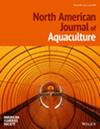Copper Toxicity to the Ghost Rams‐Horn Snail Biomphalaria havanensis
IF 1.3
4区 农林科学
Q3 FISHERIES
引用次数: 0
Abstract
Abstract Avian piscivores cause direct economic losses to the aquaculture industry through predation, as well as indirect losses through transmission of digenetic trematodes. Bolbophorus damnificus is a trematode parasite associated with significant losses in catfish aquaculture. The complex life cycle involves the American white pelican Pelecanus erythrorhynchos , planorbid snails, and ictalurid catfish. With no approved therapeutics for B. damnificus in catfish Ictalurus spp. and federal protections on American white pelican, management is restricted to controlling snail hosts. Two snail species, marsh rams‐horn snail Planorbella trivolvis and ghost rams‐horn snail Biomphalaria havanensis , are common inhabitants of commercial catfish ponds and known to transmit B. damnificus . Previous work evaluated copper sulfate toxicity on marsh rams‐horn snails; however, data are lacking for ghost rams‐horn snails. Herein, laboratory‐reared adults of ghost rams‐horn snails and marsh rams‐horn snails were exposed to copper concentrations ranging from 0.16 to 3.38 mg/L Cu to evaluate 24‐, 48‐, and 72‐h acute toxicity. Additionally, sequential low‐dose treatments ranging from 0.1 to 0.8 mg/L Cu were evaluated on eggs, juveniles, and adults of ghost rams‐horn snails as a potentially safer treatment regime for ponds. Acute toxicity was similar between snail species for all exposure times. A 72‐h exposure produced an LC50 of 0.10 and 0.37 mg/L Cu for ghost rams‐horn snails and marsh rams‐horn snails, respectively. The LC50 values increased to 1.1 mg/L Cu for both species with 48‐h exposure. However, in the multiple low‐dose study, a single dose of 0.4 or 0.8 mg/L Cu was lethal to all adult snails after 1 week, as was 0.2 mg/L Cu after two doses. Four doses of 0.1 mg/L Cu or greater killed all ghost rams‐horn snail juveniles. Results indicate that marsh rams‐horn snails and ghost rams‐horn snails have similar sensitivity to copper, and multiple low‐dose treatments were effective against all life stages of ghost rams‐horn snails. These data indicate that copper can be an effective treatment for snail control in commercial catfish ponds.铜对哈瓦那羊角螺的毒性
摘要禽食动物通过捕食给水产养殖业造成直接经济损失,也通过传播遗传寄生虫造成间接经济损失。有害吸虫是一种吸虫寄生虫,与鲶鱼养殖业的重大损失有关。这种复杂的生命周期包括美国白鹈鹕(pelenanus erythrorhynchos)、planorbid蜗牛和ictalurid鲶鱼。由于没有批准的治疗Ictalurus类鲶鱼的有害B.的药物,以及联邦政府对美国白鹈鹕的保护,管理仅限于控制蜗牛宿主。沼泽公羊角蜗牛Planorbella trivolvis和哈瓦那鬼公羊角蜗牛Biomphalaria havanensis这两种蜗牛是商业鲶鱼池塘的常见居民,已知它们会传播有害双胞杆菌。先前的研究评估了硫酸铜对沼泽公角螺的毒性;然而,缺乏关于羊角螺的数据。本研究将实验室饲养的成年鬼羊角螺和沼泽羊角螺暴露于浓度为0.16 - 3.38 mg/L的铜环境中,以评估24 -、48 -和72 - h的急性毒性。此外,将0.1 - 0.8 mg/L的顺序低剂量处理作为池塘中可能更安全的处理方案,在卵、幼螺和成虫上进行了评估。在所有暴露时间内,不同种类蜗牛的急性毒性相似。暴露72 h后,鬼羊角螺和沼泽羊角螺的LC50分别为0.10和0.37 mg/L Cu。暴露48小时后,两种物种的LC50值均增加到1.1 mg/L Cu。然而,在多次低剂量研究中,单剂量0.4或0.8 mg/L的铜在1周后对所有成年蜗牛都是致命的,两剂量0.2 mg/L的铜在1周后也是致命的。四次0.1 mg/L或更高剂量的铜杀死了所有的鬼羊角蜗牛幼崽。结果表明,沼泽公羊角螺和鬼羊角螺对铜具有相似的敏感性,多次低剂量处理对鬼羊角螺的各个生命阶段都有效。这些数据表明,铜可以有效地控制商业鲶鱼池塘的蜗牛。
本文章由计算机程序翻译,如有差异,请以英文原文为准。
求助全文
约1分钟内获得全文
求助全文
来源期刊
CiteScore
2.50
自引率
0.00%
发文量
46
审稿时长
18-36 weeks
期刊介绍:
The North American Journal of Aquaculture publishes papers on new research and practical experience in all areas of intensive and extensive fish culture. Topics include broodstock selection and spawning, nutrition and feeding, health and water quality, facilities and production technology, and the management of ponds, pens, and raceways.
The journal will consider papers dealing with ways to improve the husbandry of any aquatic species—marine or freshwater, vertebrate or invertebrate—raised for commercial, scientific, recreational, enhancement, or restoration purposes that may be of interest to practitioners in North America. Its scope includes both basic and applied science, but applied scientific endeavors—including practical experiences, descriptive studies, and other nontraditional, but pertinent works—are emphasized.

 求助内容:
求助内容: 应助结果提醒方式:
应助结果提醒方式:


